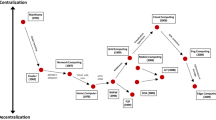Abstract
Replication of data is a popular and convenient form of data organization in distributed systems. Together with its advantages, data replication brings specific problems, which have to be solved by system designers. This paper deals with methods for resolving inconsistencies in data replication. The problem investigated in this work is: How to restore the data consistency if after some time of functioning their versions differ from each other on some sites of the system. We propose a solution of this problem by determining consensus of replicated data versions. We assume that there is a possibility to define a distance function between versions of replicated data, next different consensus choice functions are defined and analyzed. A numerical and practical example of applying these methods is also presented.
Similar content being viewed by others
References
M.A. Aizerman, “New problems in the general choice theory,” Social Choice Welfare, vol. 2, pp. 235–282, 1985.
K.J. Arrow, Social Choice and Individual Values, Wiley: New York, 1963.
J.H. van Bemmel, J. Fox, and K. Bernstein, “Multimedia shared patient records--uropean experiences,” in Proceedings of Twelfth International Symposium on the Creation of Electronic Health Record System and Global Conference on Patient Cards 2, 1996, pp. 164–169.
R.E. Blahut, Theory and Practice of Error Control Codes, Addison Wesley, 1984.
K.P. Bogart, “Preference structure I: Distance between transitive preference relations,” Journal of Mathematical Sociology, vol. 3, pp. 455–470, 1984.
M. Buretta, “Using transaction-based and transaction-consistent asynchronous replication,” 1997. Available at http://www-4.ibm.com/software/data/pubs/papers.
S. Ceri and G. Pelagatti, Distributed Databases, Principle and Systems, McGraw-Hill, 1984.
G. Coulouris, J. Dollimore, and T. Kindberg, Distributed Systems, Concepts and Design, Addison Wesley, 1996.
C. Danilowicz and N.T. Nguyen, “Determining of the problem solutions representations,” in Proceedings of the 5th International Conference on Artificial Intelligence and Information-Control Systems of Robots-87, North-Holland, 1987, pp. 185–190.
C. Danilowicz and N.T. Nguyen, “Consensus-based partition in the space of ordered partitions,” Pattern Recognition, vol. 21, 1988, pp. 269–273.
C. Danilowicz and N.T. Nguyen, “Consensus-based methods for restoring consistency of replicated data,” in Advances in Soft Computing, Proceedings of 9th International Conference on Intelligent Information Systems'2000, Springer Verlag, 2000, pp. 325–336.
W.H.E. Day, “Extremes in the complexity of computing metric distance between partitions,” IEEE Transaction on Pattern Analysis and Machine Intelligence, vol. 6, pp. 69–73, 1984.
W.H.E. Day, “Consensus methods as tools for data analysis,” in Classification and Related Methods for Data Analysis, H.H. Bock (Ed.), North-Holland, 1988, pp. 312–324.
P.C. Fishburn, “Semiorders and the theory of choice,” Econometrica, vol. 43, pp. 975–977, 1975.
P.C. Fishburn, “Condorset social choice functions,” SIAM Journal on Applied Mathematics, vol. 33, pp. 469–489, 1977.
J.G. Kemeny, “Mathematics without numbers,” Daedalus, vol. 88, pp. 577–591, 1959.
A. Kumar and K. Malik, “Optimizing the cost of hierarchical quorum consensus,” Acta Informatica, vol. 33, pp. 255–275, 1996.
W. Lipski and W. Marek, Combinatorial Analysis, WTN Warsaw, 1986.
I.M. Makarov, T.M. Vinograskaya, A.A. Rubchinsky, and V.B. Sokolov, The Theory of Choice and Decision Making, Mir Publisher Moscow, 1987.
N.T. Nguyen, “The axiom approach to the experts opinions representation choice problem,” in Proceedings of the 13th International Conference on System Science. Wroclaw Univ. of Technology, 1998, pp. 224–229.
N.T. Nguyen, “Using consensus methods for solving conflicts of data in distributed systems,” Lecture Notes in Computer Science, vol. 1963, pp. 411–419, 2000.
T.M. Ozsu, Principles of Distributed Database Systems, Prentice-Hall, 1991.
J. Paris and D. Long, “Efficient dynamic voting algorithms,” in Proceeding of the Fourth International Conference on Data Engineering, 1988, pp. 268–275.
J. Paris and D. Long, “Voting with regenerable volatile witnesses,” in Proceeding of the Seventh International Conference on Data Engineering, 1991, pp. 112–119.
Z. Pawlak, “An inquiry into anatomy of conflicts,” Journal of Information Sciences, vol. 109, pp. 65–78, 1998.
H. Pham, “Optimal cost design of replicated data in distributed database systems,” International Journal of System Science, vol. 29, pp. 795–804, 1998.
H. Pham and D. Potocki, “Anoptimal static pessimistic scheme for distributed database systems,” in Proceeding of the Third International Conference on Reliability, Quality Control and Risk Assessment, Washington DC, 1994, pp. 23–26.
R.H. Thomas, “A majority consensus approach to concurrency control for multiple copy databases,” ACM Transaction on Database Systems, vol. 4, pp. 180–209, 1979.
Author information
Authors and Affiliations
Rights and permissions
About this article
Cite this article
Danilowicz, C., Nguyen, N.T. Consensus Methods for Solving Inconsistency of Replicated Data in Distributed Systems. Distributed and Parallel Databases 14, 53–69 (2003). https://doi.org/10.1023/A:1022835811280
Issue Date:
DOI: https://doi.org/10.1023/A:1022835811280




